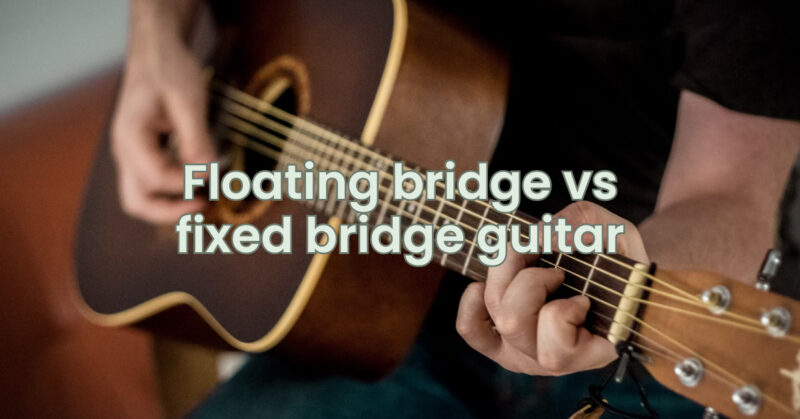The bridge of an electric guitar plays a significant role in determining its playability, tone, and versatility. When it comes to bridge options, two popular choices are the floating bridge and the fixed bridge. Each option offers distinct advantages and considerations that can greatly impact your playing experience and the sounds you can achieve. In this article, we will explore the differences between a floating bridge and a fixed bridge guitar, helping you make an informed decision based on your playing style and preferences.
Floating Bridge:
A floating bridge, also known as a tremolo or vibrato bridge, is designed to pivot and move with the tension of the strings. This allows for pitch modulation in both upward and downward directions using the tremolo arm. Floating bridges are commonly found on guitars like the Fender Stratocaster.
Pros of a Floating Bridge:
- Pitch Modulation: The primary advantage of a floating bridge is the ability to use the tremolo arm to raise or lower the pitch of notes. This provides expressive techniques such as vibrato, dive bombs, and subtle pitch bends, allowing for a wide range of musical expression.
- Tremolo Effects: The floating bridge, when combined with the tremolo arm, enables the creation of dynamic tremolo effects. From subtle warbles to dramatic pitch fluctuations, these effects add depth and character to your playing, making your guitar sound more versatile and expressive.
Cons of a Floating Bridge:
- Tuning Stability: One of the challenges with a floating bridge is maintaining tuning stability. Changes in string tension caused by aggressive playing, string bending, or the use of the tremolo arm can result in the guitar going out of tune more easily. Proper setup, regular maintenance, and careful playing techniques are necessary to minimize tuning issues.
- Setup Complexity: Setting up a floating bridge requires precise adjustments to achieve the desired string height, known as the action, and overall balance. Finding the right balance between comfortable playing and avoiding unwanted string buzz can be time-consuming and requires patience.
Fixed Bridge:
A fixed bridge, also known as a hardtail bridge or non-tremolo bridge, is a stationary bridge system that does not allow for pitch modulation using a tremolo arm. The strings are anchored securely to the bridge, providing stability and sustain.
Pros of a Fixed Bridge:
- Tuning Stability: One of the main advantages of a fixed bridge is its superior tuning stability. Since there is no movement or pivot point, changes in string tension have minimal impact on the overall tuning of the guitar. This makes a fixed bridge a reliable choice for players who require stable tuning, especially during aggressive playing or heavy string bending.
- Simplified Setup and Maintenance: Compared to a floating bridge, a fixed bridge is generally easier to set up and maintain. There are no moving parts or intricate adjustments to worry about, making it a more straightforward option for players who prefer a stable and hassle-free setup.
Cons of a Fixed Bridge:
- Limited Pitch Modulation: With a fixed bridge, the ability to perform upward pitch modulation using a tremolo arm is eliminated. This limitation restricts your ability to achieve wide vibrato and other expressive techniques associated with upward pitch modulation.
- Reduced Tremolo Effects: Without the ability to raise the pitch, the range of dynamic tremolo effects is diminished. While you can still perform downward bends and achieve some degree of vibrato through finger manipulation, the versatility of a floating bridge is not present.
Choosing the Right Bridge for You:
When deciding between a floating bridge and a fixed bridge guitar, consider the following factors:
- Playing Style: If you value pitch modulation techniques, expressive playing, and a wide range of tremolo effects, a floating bridge may be the better choice. However, if you prioritize tuning stability and prefer a simpler setup, a fixed bridge offers a reliable and low-maintenance option.
- Musical Genre: Consider the musical genre you primarily play. Floating bridges are often associated with styles like rock, blues, and country, where expressive techniques and tremolo effects are commonly utilized. Fixed bridges are popular in genres like jazz, heavy metal, and hard rock, where tuning stability and sustain are critical.
- Personal Preference: Ultimately, your personal preference as a player is essential in making a decision. If possible, try out guitars with both bridge options to see which one feels more comfortable and inspiring for your playing style.
Conclusion:
Choosing between a floating bridge and a fixed bridge guitar depends on your playing style, musical genre, and personal preferences. A floating bridge offers enhanced expressiveness, dynamic tremolo effects, and a wide range of tonal possibilities, but requires careful setup and maintenance for optimal tuning stability. A fixed bridge provides superior tuning stability, simplified setup, and reliability, but sacrifices pitch modulation capabilities. Consider your playing style, musical genre, and personal preferences to make an informed decision that suits your specific needs as a guitarist.

